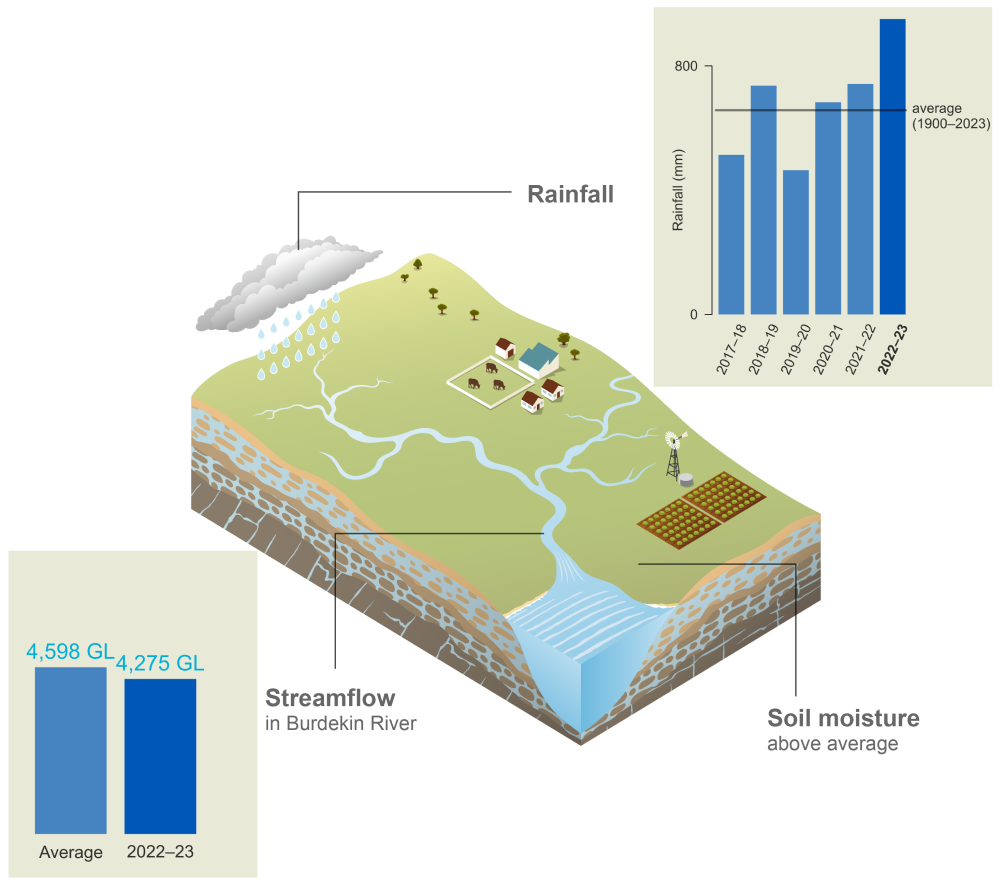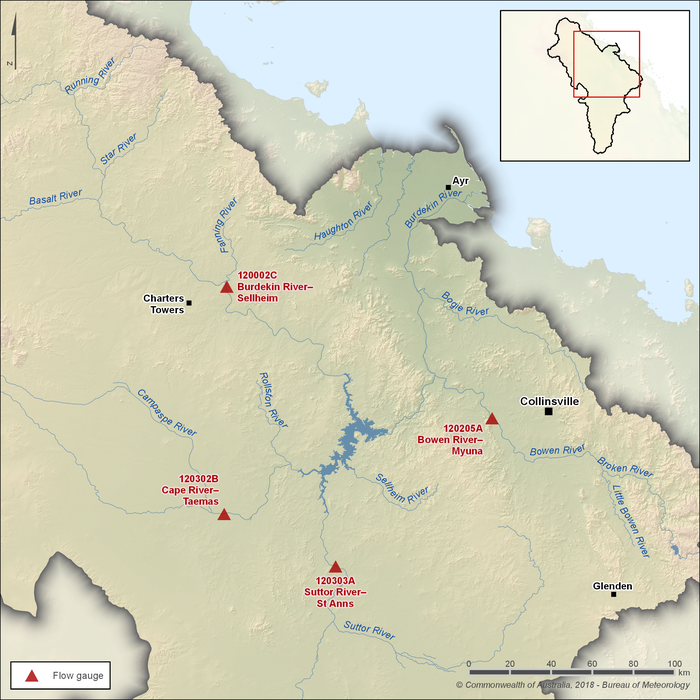Burdekin: Climate and water
For the water account period 01 July 2022 - 30 June 2023
- Total annual rainfall for the 2022-23 year was above average for the third consecutive year, and the tenth highest on record for the region.
- July 2022 was the wettest July since 1900 and spring rainfall was very much above average in most areas.
- Soil moisture in the root zone (0-1 m depth) predominantly above average across the region, reflecting the region's above average rainfall.
- Total annual flows in the region's major rivers were above average at all sites except for the Burdekin River at Sellheim (the region's largest river), where total annual flows were close to average.

For further information on the region's climate and water conditions during the 2022-23 year scroll down this page or click on the links below:
About the region
- The Burdekin region lies within two climatic zones, with the climate east of the Great Dividing Range characterised by tropical monsoonal conditions (hot and humid summers, and warm and dry winters), while the climate west of the Great Dividing Range is characterised by dry tropical conditions (hot and dry summers, and warm and dry winters).
- Most of the region's rainfall occurs during the northern Australian wet season (October to April), associated with the active phases of the monsoon and tropical cyclone activity. Rainfall east of the Great Dividing Range is far greater to areas west of the Great Dividing Range.
- Streamflows in the region's rivers are generally seasonal, reflecting the wet-dry climate of the region. Higher streamflows and storage inflows occur during the northern wet season (October to April), while streamflows can cease to flow during the northern dry season (May to September).
Climate conditions
Rainfall
Figure C1 Annual and monthly rainfall deciles for the Burdekin region during the 2022–23 year
- Total area-averaged rainfall for the 2022-23 year was 951 mm, 45% above the mean value of 657 mm and the tenth wettest year since 1900.
- An unseasonable rainband brought more than six times the monthly average during July 2022, resulting in the region's wettest July on record.
- In September 2022, a La Niña event was declared for the third consecutive year, and remained active through to March 2023. La Niña events tend to increase the chances of above average rainfall during the northern wet season.
- Spring rainfall was very much above average (the seventh wettest on record) and notably high over the catchment area for the region's main storage Lake Dalrymple.
- A slow moving tropical low embedded in the monsoonal trough produced flooding rains and thunderstorms to the region during January 2023. Another monsoonal trough brought rain to the region during February 2023, however, rainfall remained below average for the month.
- Early autumn, was close to average but little rainfall was recorded in May 2023 and June 2023, with the region recieving only 9% of the May to June monthly averages combined.
- Rainfall during the 2022-23 wet season was above average, accounting for 80% of the region's total area-averaged rainfall for 2022-23. More information on the 2022-23 wet season can be found at Australia's 2022-23 Northern Wet Season.
- More information on Australia's climate and water over the 2022-23 year can be found at Financial year climate and water statement 2022-23.
Figure C2 Total monthly rainfall for the Burdekin region during the 2022–23 year compared with the average and percentiles for the region
- The rainfall in July 2022 was over six times the monthly average and the highest July total on record for the region.
- Above-average rainfall fell during the 2022-23 wet season (October 2022 to April 2023) with September 2022, October 2022, November 2022, and January 2023 peaking above the 90th percentile. Rainfall during the last three months of the wet season (February to April 2023) was close to average.
- Little rainfall fell during the last two months of the 2022-23 year (May to June 2023) with May rainfall falling below the 10th percentile.
Actual evapotranspiration
Figure C3 Annual and monthly actual evapotranspiration deciles for the Burdekin region during the 2022–23 year
- Annual actual evapotranspiration for the 2022-23 year was very much above average across the region, with high rainfall increasing the water availably across the region for much of the year.
- Record breaking rainfall during July 2022 resulted in above average evapotranspiration for most the region through to the beginning of the 2022-23 wet season.
- Following the onset of the 2022-23 wet season, a very wet spring and January further increased water availability across the region, maintaining above average evapotranspiration throughout spring and and summer.
- By the end of the 2022-23 wet season, evapotranspiration was average to above average following near average rainfall across the region from February to April 2023.
- Little rainfall during May 2023 and June 2023 resulted in average to below average evapotranspiration for the last two months of the 2022-23 year.
Soil moisture
Figure C4 Annual and monthly soil moisture deciles for the Burdekin region during the 2022–23 year
- Soil moisture in the root zone (0–1m depth) for the 2022-23 year was very much above average across most of the region.
- A very wet July 2022 resulted in very much above average soil moisture, with central parts of the region experiencing highest July soil moisture on record and high soil moisture maintained into early spring.
- Following the onset of the 2022-23 wet season, soil moisture remained above average during spring and summer due to continued high rainfall over this period.
- By the end of the 2022-23 wet season, rainfall was closer to average and soil moisture conditions gradually returned to average from February to April 2023.
- Little rainfall during May 2023 and June 2023 resulted in below average soil moisture for the last two months of the 2022-23 year.
- More information on soil moisture distribution across the Burdekin region is available in the Australian Water Outlook.
Streamflow responses

Figure C5 Key flow gauging stations along the main rivers within
the Burdekin region
- The Burdekin, Cape and Suttor rivers are three primary rivers that flow into Lake Dalrymple, which supports the region's Burdekin Haughton Water Supply Scheme.
- The Bowen River is downstream of Lake Eungella and provides water for the region's Bowen Broken Water Supply Scheme.
Figure C6 Total monthly flow for major rivers in the Burdekin region during the 2022–23 year compared with the average and percentiles
- With high rainfall and soil moisture for much of the 2022-23 year, total annual flows in the region's major rivers were above average at all sites during, except the Burdekin River at Sellheim (Station 120002C). For the Burdekin River at Sellheim, the region's largest river, streamflows were close to average, with a total annual flow volume of 4,275 GL compared to the average annual flow volume of 4,598 GL.
- Unseasonable rainfall caused all streamflows to peak above the 90th percentile during July 2022, with the Cape River at Taemas (Station 120302B) recording its highest streamflow on record for July.
- During the lead up to the 2022-23 wet season (August to September 2022), streamflows returned to low but near average volumes.
- In response to high widespread rainfall, streamflows in the Cape River at Taemas and the Suttor River at St Anns (Station 120303A) peaked above the 90th percentile from October to December 2022. Streamflow also peaked above the 90th percentile in November 2022 for the Bowen River at Myuna (Station 120205A), but remained near average for the Burdekin region throughout spring and into early summer.
- A monsoonal trough brought heavy rain to the region throughout January 2023, resulting in streamflows in the Bowen River at Myuna and Suttor River at St Anns peaking near or above the 90th percentile.
- Despite another monsoonal trough affecting the region during February 2023, streamflows were below average at all sites except for the Suttor River at St Anns.
- By March 2023, all streamflows dropped to below average and, with near average rainfall from February to April 2023, remained below average throughout autumn.
- Little rainfall was recorded across the region during May 2023 and June 2023, resulting in low flows, with streamflows in the Suttor River at St Anns ceasing to flow during the last two months of the 2022-23 year.
Note: Streamflow data for the Bowen River at Myuna (Station 120205A) was only available until April 2023









